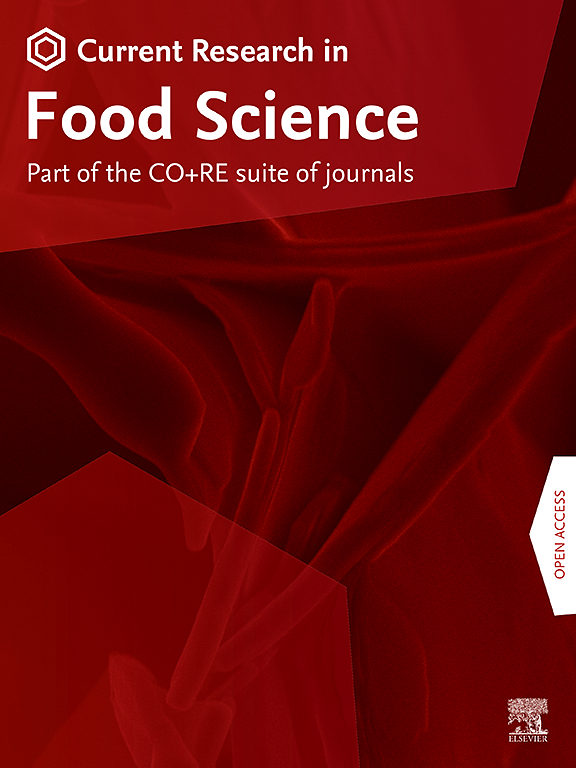Structural characterization and preliminary functional evaluation of a novel Polysaccharide NS0-1 from Nostoc sphaeroides Kütz
IF 7
2区 农林科学
Q1 FOOD SCIENCE & TECHNOLOGY
引用次数: 0
Abstract
Nostoc sphaeroides polysaccharides exhibit diverse bioactivities, but the link between their structural features and functional properties remains underexplored. In this study, a novel heteropolysaccharide, NS0-1, was extracted and purified from Nostoc sphaeroides Kütz., and characterized using FT-IR, AFM, GC-MS, HPLC, and NMR. The backbone consists of (1 → 4)-β-D-Glcp, (1 → 4)-α-D-Manp, and (1 → 4)-β-D-Xylp, with branches containing α-D-GlcUA, α-D-Galp, and (1 → 3,5)-β-D-Galf. Rare structural features such as O-2 acetylated mannose and galactofuranose were identified. NS0-1 showed moderate α-amylase inhibitory activity (36.11 % at 1 mg/mL), along with shear-thickening and weak gel-like rheological behavior. Molecular docking and 50 ns molecular dynamics simulations revealed stable binding with α-amylase through multiple hydrogen bonds, suggesting a structure-based inhibitory mechanism. These results highlight the importance of acetylation and branching in determining bioactivity and physicochemical properties. NS0-1 holds promise as a multifunctional ingredient in functional foods, particularly for glycemic control and texture modification. Further kinetic and in vivo studies are needed to confirm its therapeutic relevance.

新多糖NS0-1的结构表征及初步功能评价
念珠菌多糖具有多种生物活性,但其结构特征与功能特性之间的联系尚不清楚。本研究从念珠菌(Nostoc sphaeroides k tz)中提取并纯化了一种新的杂多糖NS0-1。,并通过FT-IR、AFM、GC-MS、HPLC和NMR进行了表征。骨干由(1→4)-β-D-Glcp,(1→4)-α-D-Manp,和(1→4)-β-D-Xylp,用树枝含α-D-GlcUA,α-D-Galp,和(1→3、5)-β-D-Galf。发现了O-2乙酰化甘露糖和半乳糖呋喃糖等罕见的结构特征。NS0-1表现出中等α-淀粉酶抑制活性(1mg /mL时为36.11%),剪切增厚和弱凝胶样流变行为。分子对接和50 ns分子动力学模拟显示,其与α-淀粉酶通过多个氢键稳定结合,表明其抑制机制基于结构。这些结果突出了乙酰化和支化在决定生物活性和理化性质中的重要性。NS0-1有望成为功能性食品中的多功能成分,特别是用于血糖控制和质地改变。需要进一步的动力学和体内研究来证实其治疗相关性。
本文章由计算机程序翻译,如有差异,请以英文原文为准。
求助全文
约1分钟内获得全文
求助全文
来源期刊

Current Research in Food Science
Agricultural and Biological Sciences-Food Science
CiteScore
7.40
自引率
3.20%
发文量
232
审稿时长
84 days
期刊介绍:
Current Research in Food Science is an international peer-reviewed journal dedicated to advancing the breadth of knowledge in the field of food science. It serves as a platform for publishing original research articles and short communications that encompass a wide array of topics, including food chemistry, physics, microbiology, nutrition, nutraceuticals, process and package engineering, materials science, food sustainability, and food security. By covering these diverse areas, the journal aims to provide a comprehensive source of the latest scientific findings and technological advancements that are shaping the future of the food industry. The journal's scope is designed to address the multidisciplinary nature of food science, reflecting its commitment to promoting innovation and ensuring the safety and quality of the food supply.
 求助内容:
求助内容: 应助结果提醒方式:
应助结果提醒方式:


